Formation of Large-Scale Eddies in the Bay of Bengal during Summer Monsoon
W A A P Wijesundara1 and S U P Jinadasa2*
1National Aquatic Resources Research and Development Agency (NARA), Crow Island, Sri Lanka
2The Ocean University of Sri Lanka, Crow Island, Sri Lanka
Submission:March 06, 2023; Published:April 03, 2023
*Correspondence author: S U P Jinadasa, The Ocean University of Sri Lanka, Crow Island, Sri Lanka
How to cite this article:W A A P Wijesundara and S U P Jinadasa. Formation of Large-Scale Eddies in the Bay of Bengal during Summer Monsoon. Oceanogr Fish Open Access J. 2023; 16(1): 555930. DOI: 10.19080/OFOAJ.2023.16.555930
Abstract
Air-sea Interaction in the Indian Ocean (ASIRI) is originally designed to study the Indian Oceanography and its inter-connection with the Indian Ocean monsoon. Circulation in the Indian Ocean and it’s variability was one of the key objectives of the program. As part of this program, first drifter deployment was carried out in August 2013 off south of Sri Lanka to investigate the circulation patterns around Sri Lanka. The main target of this deployment was to investigate intensification of the circulation patterns with southwest monsoon wind. Past studies indicated that the Bay of Bengal region is substantially influencing for the Indian Ocean monsoon. The observations results indicated that the speed of surface current was ~1 m/s throughout the drifter trajectory in the Bay of Bengal. The inertial periods calculated based on different geographical locations (4.5°N, 6°N and 10°N) were recorded as 12.7 days, 9.5days and 5.8 days respectively. Also, the formation of large-scale eddies with 200 to 400kms diameters were observed in sea surface height anomaly maps which are consistent with the estimated diameters based on drifter trajectories.
Further, it was noted that both drifters follow the parallel pathway at the beginning, until reaching 82°E and then separated and followed different paths. Apart from that the formation of mushroom like eddies were identified as characteristic features in the region. Sea surface height anomalies were observed in the years 2013 and 2014 and it is indicated the formation of 8 to 10 numbers of large-scale eddies during the southwest monsoon season. Further the formation, development and disappearing of Sri Lanka Dome was the dominant feature in the Bay of Bengal which could be observed in the satellite derived sea surface height anomaly maps.
Keywords: Indian ocean monsoon; Drifter deployment; Circulation patterns; Eddies; Bay of Bengal
Keywords:ASIRI: Air-Sea Interaction in the Indian Ocean; IO: Indian Ocean; AS: Arabian Sea; BoB: Bay of Bengal; EICC: East Indian Coastal Currents; ASIRI: Air-Sea Interaction in the Indian Ocean; AS: Arabian Sea; EICC: East India Coastal Currents; SVP: Surface Velocity Program; NARA: National Aquatic Resources Research and Development Agency; SIO: Scripps Institution of Oceanography; SSHA: Sea Surface Height Anomalies Data; EICC: East Indian Coastal Currents; SSH: Sea Surface Height; SM: Southwest Monsoon; SD: Sri Lanka Dome; CE: Cyclonic Eddy; AE: Anti-Cyclonic Eddy; EICC: East Indian Coastal Currents
Introduction
Indian Ocean (IO) is identified as the least explored and most complex ocean among the world’s major oceans. The Ocean consists of two subdivisions namely the Arabian Sea (AS) in the west and the Bay of Bengal (BoB) in the east which are geographically located in the same latitude and comprise with unique characteristics. Both basins are influenced by the Indian and Asian monsoons. The surface circulation is characterized by the seasonally reversing currents (Figure 1) as response to the seasonal winds [1].
The BoB receives substantial amount of freshwater from large Indian river discharge to the Bay of Bengal and precipita tion during southwest monsoon where precipitation well exceeds evaporation [1,2] which maintain low saline conditions in the Bay. The comparison of two basins shows high salinity difference due to high evaporation over AS and high freshwater influx to the BoB which leads to hydrological imbalance between the AS and BoB [3]. The seasonally reversing circulations play a key role in controlling the imbalance between AS and the BoB which maintains long-term average salinities in the Indian Ocean [4]. The observations based on earlier studies [2,5,6] and model simulations [4,7,8] pointed out that the flow of water mass towards eastward direction. Further, it was noticed that the westward propagation of Northeast Monsoon Current (NMC) carries low saline BoB waters into the AS during northeast monsoon. Thus, the circulation within the BoB is affected by the seasonal variability of current patterns in the Indian Ocean. East Indian Coastal Currents (EICC), which runs along the western boundary of the BoB reverses its direction twice a year [7,5]. Within this seasonal cycle, EICC plays a crucial role in the freshwater balance of the northern Indian Ocean during northeast monsoon since it is an efficient conduit for the export of low salinity water from the BoB to the Arabian Sea [9].
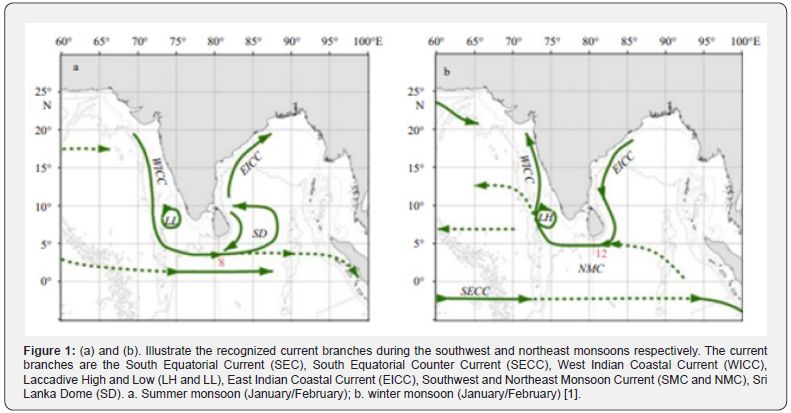
The present study (drifter deployment program) was carried out during 2013 to 2015 as the framework of Air-Sea Interaction in the Indian Ocean (ASIRI) project off south and east coasts of Sri Lanka. The program consists of different objectives such as coastal boundary currents and water mass exchange between Bay of Bengal (BoB) and the Arabian Sea (AS) [10,11]. The perspectives of ASIRI were to improve the present knowledge of coupled air sea interactions in the Indian Ocean region [12].
The study carried by Trott and Subrahmanyam in 2023 revealed that the eddies are located in the meandering East India Coastal Currents (EICC) in the western Bay of Bengal. Also, they could observe the propagation of coastally trapped Kelvin waves into the Andaman Sea varies with monsoon intensity. Also, it is interesting to note that the formation of meso-scale eddies [13] and inertial waves [14] stir water in the interior of the BoB, leading to an array of smaller scale local instabilities. They further indicated that turbulence in the region may produce mixing and vertical exchange of properties, especially biogeochemical fluxes [3].
This is an attempt to understand the circulation pathways from southwest to northeast in the Bay of Bengal region based on drifter data together with satellite altimetry data during 2013- 2015. This was the first effort to study Bay of Bengal circulation based on SVP drifter trajectories.
Materials and Methods
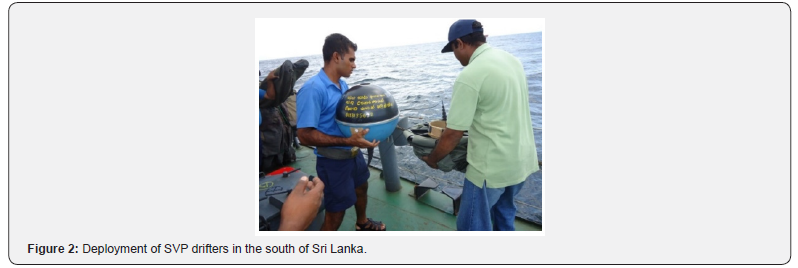
The data from satellite tracked SVP (surface velocity program) drifters deployed in south of Sri Lanka (Figure 2) were used to study the surface circulation patterns in the BoB from southwest to northeast monsoon period. The investigations were conducted as part of the ASIRI program by National Aquatic Resources Research and Development Agency (NARA) of Sri Lanka collaboratively with Scripps Institution of Oceanography (SIO), University of California, USA. Sea surface height anomalies data (SSHA) were obtained from Aviso satellites [15] were integrated for this study.
Apart from the study on drifter trajectories, we have obtained sea surface height anomaly (SSHA) data from “Aviso” altimetry satellites for the period from August to November 2013 and 2014. The SSHA data were selected in the Indian Ocean region (55 to 100°E and 5°S to 25°N) but analysis was done only for the Bay of Bengal region. SSHA maps were prepared using software and “iocoast” coastline map was overlapped with the SSHA maps to observe geographical settings of large-scale eddy formations in the region. Also, we have estimated the size of eddies based on the map scale.
Results
Surface drifter trajectories from southwest to northeast monsoon
The figure 3 illustrates the drifter trajectories of two drifters deployed in south of Sri Lanka in August 2013. Drifters were deployed with 3 hours’ time lap and separated by 25 nautical miles from each other.
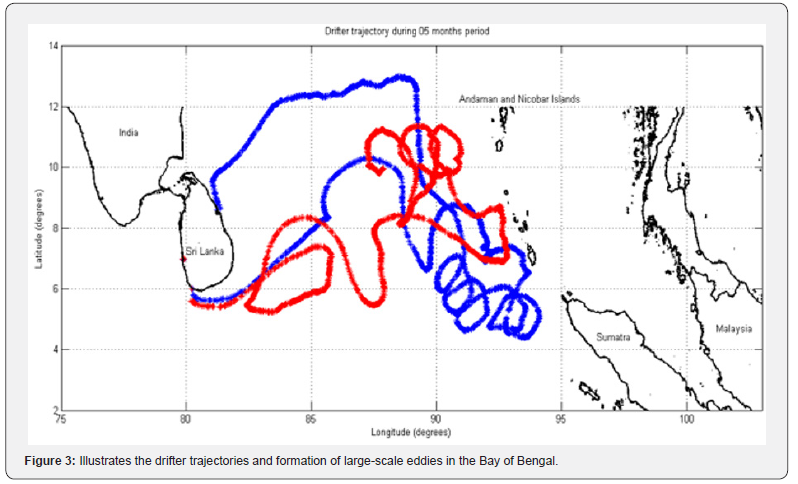
At the beginning, both drifters followed the southwest monsoon current patterns and started to separate at 82°E where they followed completely opposite directional pathways. After that it could be assumed both drifters were free from the influence of southwest monsoon currents. Further it could be observed that formation of cluster of mushrooms like eddies which were significant to the large-scale eddy formation in the region. At the latter part of the trajectory drifters were under controlled by the East Indian Coastal Currents (EICC) and reached to east coast of Sri Lanka completing their journey.
The estimation of current speed indicated that both drifters travelled with average speed of ~1 m/s throughout the drifter trajectory in the region. The periods of eddies were calculated based on inertial force in different latitudes at 4.5°N, 6°N and 10°N and inertial periods were 12.7 days, 9.5days and 5.8 days respectively in such specific locations. Further, eddy diameters were calculated based on sea surface height anomalies and diameters of the eddies vary from 200 to 400kms in the region which are consistent with the estimated diameters based on drifter trajectories.
Sea Surface Height (SSH) Anomaly controlled the Eddy Formation in the Bay of Bengal during Southwest Monsoon (SM) to Northeast monsoon 2013. The monthly averaged sea surface height anomalies (SSHA) were integrated with drifter trajectories to understand impact of monsoon driven control factors. The daily products of SSH anomaly from Aviso data set [15] in the Indian Ocean (0o-25oN and 75o-100oE) was used to simulate during August to November 2013.
Figure 4 illustrates the observed large scale eddy formation in the Bay of Bengal using satellite altimetry data. There are number of cyclonic and anti-cyclonic eddy formations represented by blue (cyclonic) and yellow (anti-cyclonic) colors in the map. The negative sea surface height anomalies (blue) are related with cold eddies which are represented by the cyclonic eddies. The positive sea surface height anomalies are represented by the warm eddies which are related with anti-cyclonic eddy formations. During August and September, sea surface height anomalies show large scale cyclonic eddy formation in the east of Sri Lanka which indicated famous cyclonic eddy formation in southwest monsoon called Sri Lanka Dome (SD). The Dome was well developed in August and September, but it disappeared during October. Apart from that it was noticed as anti-cyclonic eddy formation in this region is prominent in October.
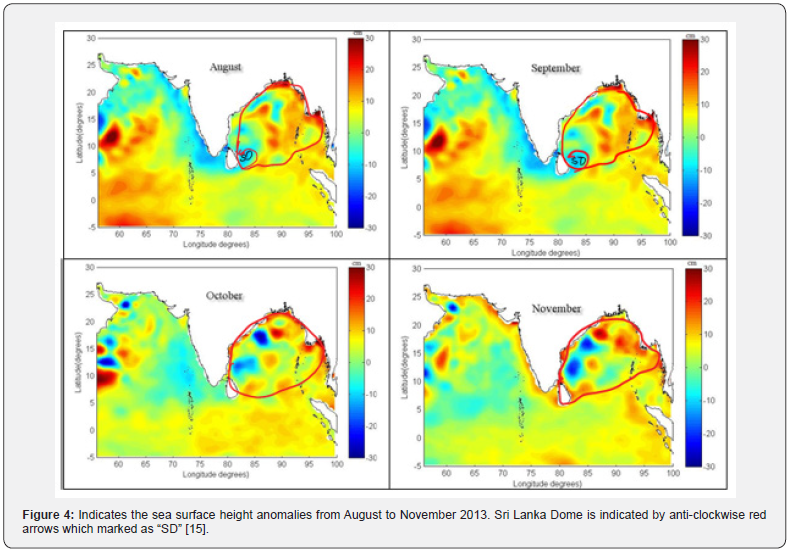
It was found that the Bay of Bengal region was covered by 8-10 large scale eddies (red circle in the diagram) throughout the study period. The estimated diameters of eddies were 200 to 400kms throughout the region. Though there are less numbers of eddy formations during August to September significant increase could be observed during October and November which probably be due to the influence of inter-monsoon activation.
The monthly averaged sea surface height anomalies (SSHA) were integrated with drifter trajectories to study controlling factors of large-scale eddy formation in the Bay of Bengal region (Figures 5a & 5b). The daily products of SSH anomaly from Aviso data [15] in the Indian Ocean (0o-25oN and 75o-100oE) was used to simulate during southwest to northeast monsoon 2014 (August to November). SSH anomalies were obtained in centimeters, and it is large as ±20 cm with westward propagation representing southwest monsoon currents (Figure 1). The SSH anomaly clearly indicated the formation of large-scale eddies during the SM which are representing both cyclonic and anti-cyclonic formations. Most of the large-scale eddies indicated the order of several hundred long and wide scales. The results further indicated the drifter trajectories are controlled by SSH anomalies in the area.
The formation of Sri Lanka Dome (SD) is the dominant feature in the Bay of Bengal found during southwest monsoon. However, present study shows the early formation of Sri Lanka Dome in 2014 which clearly indicated by the weak SD (cyclonic eddy (CE)) in August, and it was almost disappeared during September [16- 19].
Figure 6 shows the Sea surface height anomalies in the Bay of Bengal region from August to November 2014. Though large-scale eddies were found in the region, it was noted that less formation of eddies in 2014 compared to 2013. It was further noticed that an equal amount of cyclonic and anti-cyclonic eddies was formed in this period. Whole eddy formations in 2014 were shown within the red circles in the maps. The estimated diameters of the eddies were about 200-400kms however size of some eddies was greater than that.
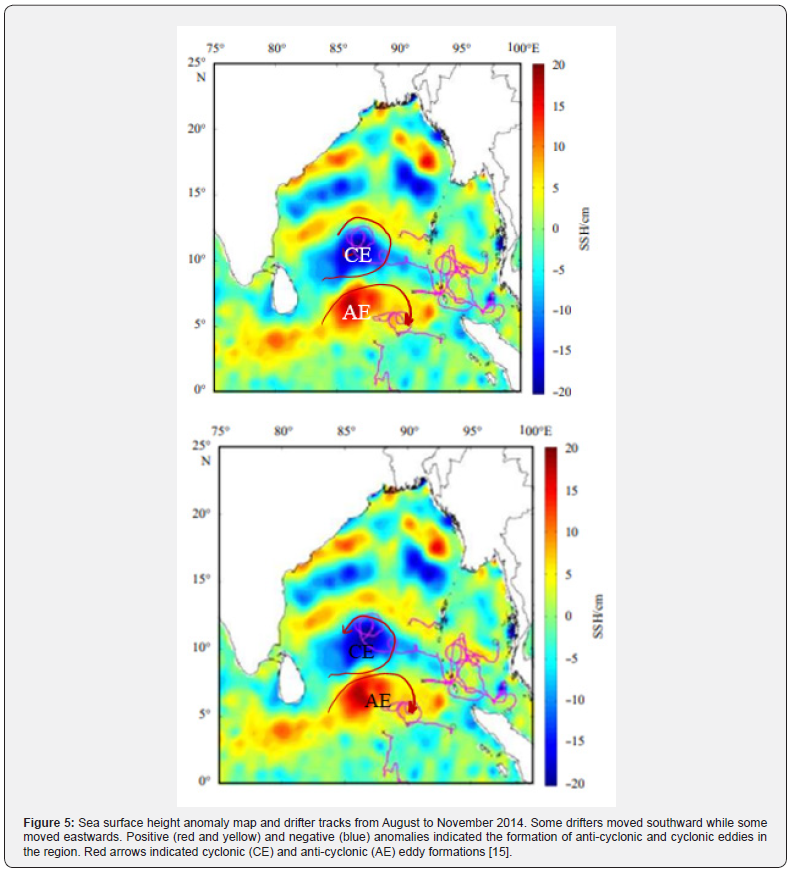
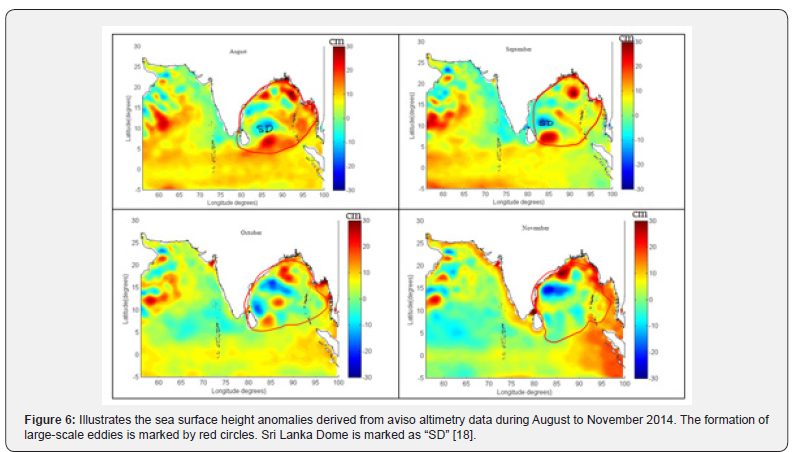
Discussion
The drifter trajectory indicated an average velocity of ~1m/s throughout the region. Calculated inertial periods of eddies-based latitudes show 12.7days, 9.5days and 5.8days. The calculated diameters of the eddies were shown between 200 to 400 km’s which are consistent with the estimated values based of drifter trajectories. Further, both trajectories followed southwest monsoon current patterns and later followed completely opposite directional pathways at 82°E. The significant features that could be observed are the formation of mushroom-like eddies in the region. At the latter part of the trajectory, drifters were under controlled by the East Indian Coastal Currents (EICC) and reached to east coast of Sri Lanka completing trajectory.
Sea surface height anomalies show that formation of eight (8) to ten (10) numbers of cyclonic and anti-cyclonic eddies in the Bay of Bengal. Large cyclonic eddy formation in the east of Sri Lanka during August and September 2013 indicated Sri Lanka Dome (SD) and its propagation towards the northeast of Sri Lanka before disappeared in October.
Conclusion
The Sea surface height anomaly during August to November 2014 clearly indicated the formation of large scale cyclonic and anti-cyclonic eddies during the southwest monsoon. The average diameters of the eddies were about 200-400kms in size but of some eddies were greater than that. The formation of Sri Lanka Dome (SD) is the dominant feature in the Bay of Bengal, formed during southwest monsoon in 2014 as well. However, it was noted that weakening of SD (CE) in August and almost disappeared in September 2014.
Acknowledgement
Authors wish to acknowledge all the supporters actively involved for drifter deployment in south of Sri Lanka. Further, we wish to extend our sincere gratitude for National Aquatic Resources Research and Development (NARA), Scripps Institution of Oceanography (SIO), University of California and University of Notre Dame for providing SVP drifters as supplementary to the ASIRI programme. Further, I wish to extend our thanks to Sri Lanka NAVY for providing suitable vessel facilities for the deployment of Sea gliders free of charge.
References
- Schott FA, McCreary JP (2001) The monsoon circulation of the Indian Ocean. Progress in Oceanography 51(1): 1-123.
- Schott F, Reppin J, Fischer J, Quadfasel D (1994) Currents and transports of the Monsoon Current south of Sri Lanka. Journal of Geophysical Research 99(C12): 25127-25141.
- Kumar SP, Narvekar J, Kumar A, Shaji C, Anand P, et al. (2004) Intrusion of the Bay of Bengal water into the Arabian Sea during winter monsoon and associated chemical and biological response. Geophysical Research Letters 31(15): L15304.
- Jensen TG (2001) Arabian Sea and Bay of Bengal exchange of salt and tracers in an ocean model. Geophysical Research Letters 28(20): 3967-3970.
- Vinayachandran PN, Yamagata T (1998) Monsoon response of the sea around Sri Lanka: generation of thermal domes and anti-cyclonic vortices. Journal of Physical Oceanography 28(10): 1946-1960.
- Gopalakrishna VV, Johnson Z, Salgaonkar G, Nisha K, Rajan CK, et al. (2005) Observed variability of sea surface salinity and thermal inversions in the Lakshadweep Sea during contrast monsoons. Geophysical Research Letters 32(18): L18605.
- De Vos A, Pattiaratchi CB, Wijeratne EMS (2014) Surface circulation and upwelling patterns around Sri Lanka. Bio-geosciences 11(20): 5909-5930.
- Zhang Y, Du Y (2012) Seasonal variability of salinity budget and water exchange in the northern Indian Ocean from HYCOM assimilation. Chinese Journal of Oceanology and Limnology 30(6): 1082-1092.
- Weiqing H, McCreary JP (2001) Modeling salinity distributions in the Indian Ocean. Journal of Geophysical Research 106(C1): 859-877.
- Lee CM, Jinadasa SUP, Anutaliya A, Centurioni LR, Fernando HJS, et al. (2016) Collaborative observations of boundary currents, water mass variability, and monsoon response in the Southern Bay of Bengal. Oceanography 29(2): 102-111.
- Wijesekera HW, Jensen TG, Jarosz E, Teague WJ, Metzger EJ, et al. (2015) Southern Bay of Bengal currents and salinity intrusions during the northeast monsoon. Journal of Geophysical Research 120(10): 6897-6913.
- Lucas AJ, Shroyer EL, Wijesekera HW, Fernando HJS, Asaro ED, et al. (2014) Mixing to monsoons: air-sea interactions in the Bay of Bengal. EOS, Transactions American Geophysical Union 95(30): 269-270.
- Jinadasa SUP, Pathirana G, Ranasinghe PN, Centurioni LR, Verena H (2020) Monsoonal impact on circulation pathways in the Indian Ocean. Acta Oceanologica Sinica 39(3): 103-112.
- Lozovatsky I, Wijesekera H, Jarosz E, Lilover MJ, Pirro A, et al. (2016) A snapshot of internal waves and hydrodynamic instabilities in the southern Bay of Bengal. Journal of Geophysical Research: Oceans 121: 5898-5915.
- (2022) www.aviso.altimetry.fr/en/data/products/sea-surface-heightproducts/global.
- Sengupta D, Raj GNB, Shenoi SSC (2006) Surface freshwater from Bay of Bengal runoff and Indonesian Throughflow in the tropical Indian Ocean. Geophysical Research Letters 33(22).
- Seo H, Shangping X, Murtugudde R, Markus J, Arthur J, et al. (2009) Seasonal effects of Indian Ocean freshwater forcing in a Regional Coupled Model. Journal of Climate 22(24): 6577-6596.
- Vinayachandran PN, Kagimoto T, Masumoto Y, Nayak SR, Yamagata T (2005) Bifurcation of the East India coastal current east of Sri Lanka. Geophysical Research Letters 32(15): L15606.
- Corinne BT, Bulusu S (2023) Eddy Characteristics and Vertical Structure in the Bay of Bengal during Different Monsoon Regimes. Remote Sensing 15(4): 1079.






























